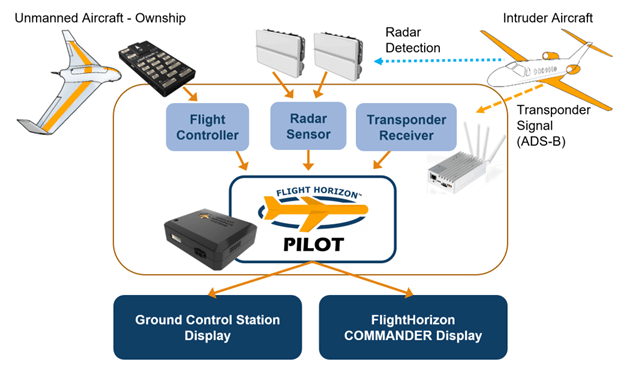New Project for Air Force Research Laboratory
Last October, Vigilant Aerospace started an important project for the Air Force Research Laboratory (AFRL) to develop a detect-and-avoid (DAA) system for long-endurance drones. This project, funded by an SBIR Phase II contract, aims to create a system for both military and civilian use. Vigilant Aerospace’s product, FlightHorizon PILOT, is designed to enhance airspace safety for uncrewed aircraft systems (UAS).
The Mission and Technology
The main goal of the project is to “integrate a mature detect and avoid capability on an existing long-endurance, Group V UAS platform for increased aircraft and pilot-in-the-loop operational awareness.” This integration uses new and evolving C-SWaP sensors and sensor fusion software.
Kraettli L. Epperson, CEO of Vigilant Aerospace, stated, “Because the FlightHorizon system was designed by NASA for its aircraft tracking and UAS safety needs and has now been adapted to the commercial market by Vigilant Aerospace, this AFRL opportunity allows us to leverage our existing products and experience, and our major investment in multi-sensor integration and algorithms, to readily fulfill the AFRL project goals and rapidly bring new capabilities to the US Air Force.”
FlightHorizon PILOT is an onboard detect-and-avoid system for drones. It consumes sensor data, detects nearby aircraft, and provides collision avoidance commands. These commands comply with the FAA’s ACAS X collision avoidance standards. The system also provides air traffic alerts and situational awareness to remote pilots. Its design is platform agnostic, meaning it can be installed on various military and civilian aircraft and use a wide range of sensors. It complies with RTCA DO-365C and DO-366 technical standards, ensuring broad applicability.

Progress and Achievements
Significant progress has been made in developing and testing the FlightHorizon PILOT product. The system has been tested with multiple radars operating simultaneously. This allows for a wide field of air traffic detection and meets industry technical standards for onboard detect-and-avoid. Radar frequency channelization has been tested to ensure multiple radars can operate without interference.
The system integrates with multiple ground control stations (GCS), including Ardupilot open-source software and other widely used systems. Vigilant Aerospace has deployed the software to various low-SWaP (space, weight, and power) computers, ensuring it can be installed on a range of aircraft. The system can operate in either a “pilot-in-the-loop” or “pilot-on-the-loop” model, providing flexibility in command execution.
The Military Need for Detect-and-Avoid Systems
Detect-and-avoid technology is crucial as the military deploys thousands of autonomous vehicles and aircraft. The US military currently operates over 11,000 UAS for training and overseas missions. These range from small RQ-11B Ravens to large RQ/MQ-4 Global Hawk/Triton aircraft. Currently, UAS must obtain a Certificate of Waiver or Authorization (COA) from the FAA for flights in civilian airspace.
Adopting detect-and-avoid systems like FlightHorizon PILOT can improve collision avoidance, increase autonomy, and provide better situational awareness. This improves integration with civilian air traffic control, leading to faster authorizations and safer transits. Better integration of UAS into national airspace can also enhance US competitiveness.
Epperson highlighted the importance of this project, saying, “This is an important project in terms of fully integrating FlightHorizon into a wider range of aircraft, which is critical to industry adoption and deployment of this technology in the future. It’s also been a highly successful collaboration, with support from the Small Business Administration (SBA), the Air Force, and the Air Force Research Lab.”
Future Implications and Civilian Applications
Beyond military needs, the development of FlightHorizon PILOT will benefit the civilian Advanced Air Mobility (AAM) market. According to Aviation Week, there will be 2,000 commercial electric vertical-takeoff-and-landing (eVTOL) vehicles by 2030, growing to 33,000 by 2050. Companies like Archer Aviation are preparing to produce 650 aircraft per year.
Epperson stated, “This project gives Vigilant the insight and expertise necessary to integrate our dual-use product into multiple aircraft systems and ground control stations, improving the availability of this critical safety system not only to multiple users across the military, but also helps to prepare us to meet the anticipated demand from the civilian Advanced Air Mobility industry for this technology.”
About AFRL
The Air Force Research Laboratory (AFRL) is the primary scientific research and development center for the Department of the Air Force. It plays a crucial role in developing affordable warfighting technologies for air, space, and cyberspace forces.
Read more:
- Ground-Based Detect and Avoid Facilitates FAA BVLOS Waiver at Michigan Test Site
- uAvionix Combines Command and Control, Detect and Avoid for BVLOS Flight at Choctaw Nation Emerging Aviation Technology Center
- Zipline Reveals Acoustic-Based Detect and Avoid Technology: Is This the Holy Grail for Drone Tech?

Miriam McNabb is the Editor-in-Chief of DRONELIFE and CEO of JobForDrones, a professional drone services marketplace, and a fascinated observer of the emerging drone industry and the regulatory environment for drones. Miriam has penned over 3,000 articles focused on the commercial drone space and is an international speaker and recognized figure in the industry. Miriam has a degree from the University of Chicago and over 20 years of experience in high tech sales and marketing for new technologies.
For drone industry consulting or writing, Email Miriam.
TWITTER:@spaldingbarker
Subscribe to DroneLife here.







Leave a Reply